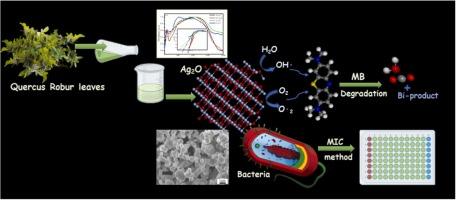氧化银纳米颗粒的绿色合成:可持续解决方案的环保方法
IF 6.2
1区 农林科学
Q1 AGRICULTURAL ENGINEERING
引用次数: 0
摘要
研究了以叶子提取物为还原剂的氧化银纳米颗粒(Ag₂O)的合成和表征,重点研究了其抗菌和光催化性能。x射线衍射(XRD)分析表明,叶片提取物没有改变Ag₂O的晶相,但影响了Ag₂O的晶粒尺寸和缺陷密度。衍射图在:2θ = 处显示出32.83°、38.08°、54.95°、65.50°和68.83°的峰,分别对应于Bragg平面(111)、(200)、(220)、(311)和(222)。平均结晶尺寸(D)在15 ~ 40 nm之间,受叶提取物浓度的影响。扫描电镜(SEM)显示,较高的叶提取物浓度使颗粒大小从100 nm减小到10 nm,促进了团聚。傅里叶变换红外光谱(FTIR)证实了Ag₂O NPs和叶片提取物上存在官能团,其波段归因于金属-氧键振动,C-O键振动和羟基。紫外可见光谱在可见区和紫外区均有较宽的吸收带,随着叶提取物浓度的升高,带隙(Eg)减小,乌尔巴赫能(Eu)增大。抗菌试验表明,Ag₂O NPs对革兰氏阳性菌和革兰氏阴性菌均有效,最低抑菌浓度(mic)在6.25 ~ 25 μg/ml之间。光催化实验表明,用叶提取物合成Ag₂O NPs的效率较低,染料降解率为68 % ~ 87 %。该研究强调了生态友好型合成Ag₂O NPs在水净化和环境催化方面的抗菌和光催化应用潜力。本文章由计算机程序翻译,如有差异,请以英文原文为准。

Green synthesis of silver oxide nanoparticles: Eco-friendly approach for sustainable solutions
The study explores the synthesis and characterization of silver oxide nanoparticles (Ag₂O) using leaf extract as a reducing agent, focusing on their antimicrobial and photocatalytic properties. X-ray diffraction (XRD) analysis showed that the leaf extract did not alter the crystalline phase of Ag₂O but affected its crystallite size and defect density. The diffractograms displayed peaks at: 2θ = 32.83°, 38.08°, 54.95°, 65.50°, and 68.83°, corresponding to the (111), (200), (220), (311), and (222) Bragg planes, respectively. The average Crystallite size (D) ranged from 15 to 40 nm, influenced by leaf extract concentration. Scanning electron microscopy (SEM) revealed that higher leaf extract concentrations reduced particle size from 100 nm to 10 nm, promoting aggregation. Fourier-transform infrared spectroscopy (FTIR) spectra confirmed the presence of functional groups on Ag₂O NPs and leaf extract, with bands attributed to metal-oxygen bond vibrations, C-O bond vibrations, and hydroxyl groups. UV-Vis spectroscopy showed broad absorption bands in both the visible and UV regions, with a reduced band gap (Eg) and increased Urbach energy (Eu) as the leaf extract concentration rose. Antimicrobial tests demonstrated the effectiveness of the Ag₂O NPs against both gram-positive and gram-negative bacteria, with minimum inhibitory concentrations (MICs) between 6.25 and 25 μg/ml. Photocatalytic tests revealed lower efficiency for Ag₂O NPs synthesized with leaf extract, with dye degradation yields ranging from 68 % to 87 %. The study highlights the potential of eco-friendly synthesized Ag₂O NPs for antimicrobial and photocatalytic applications in water purification and environmental catalysis.
求助全文
通过发布文献求助,成功后即可免费获取论文全文。
去求助
来源期刊

Industrial Crops and Products
农林科学-农业工程
CiteScore
9.50
自引率
8.50%
发文量
1518
审稿时长
43 days
期刊介绍:
Industrial Crops and Products is an International Journal publishing academic and industrial research on industrial (defined as non-food/non-feed) crops and products. Papers concern both crop-oriented and bio-based materials from crops-oriented research, and should be of interest to an international audience, hypothesis driven, and where comparisons are made statistics performed.
 求助内容:
求助内容: 应助结果提醒方式:
应助结果提醒方式:


